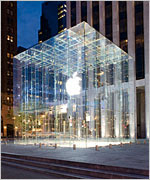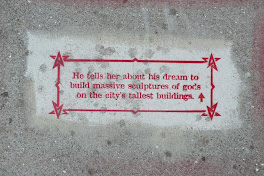
This mapping research helped me to visualize Apple stores across the nation.
You tell me where the distinction occurs between these areas.
Alright, the Aspen Apple store did look like it was in a ski village or could it have been a shop at a Disney park?
Apple is not alone in the branding of place; there is Ikea, Pottery Barn, Williams-Sonoma, and the less glamorous brands of Wal-Mart and Targets. Recognition is the key; if I was traveling in a foreign land and needed to run to the Apple store I would recognize one immediately regardless of the language barrier that may be present. Apple has taken on the logo and uses the logo for signage. The symbol of the Apple is even more universal than many of our traffic or safety symbols.Does such a universal appeal rob the public of truly experiencing place?






3 comments:
Kara,
Great image and thought! I'll be visiting that post often. I agree with your statement of "Recognition is the key", your exercise reveals Apple as a retail mogul is aiming to create a recognizable place. If Apple is arguing they are placeless, their intent is questionable. Like other retail or food chains, they are creating places that the consumer is able to identify wherever they are in the world. I am not sure what came first, the chicken or the egg, therefore I am not sure "Apple is not alone in the branding". I cannot remember how Apple Macintosh computers were available 10 years ago. The only thing I remember is trying to buy Archicad and an Apple system through a private commercial vendor. The images of the stores reveal the one consistent Logo that regardless of minor regionalism of the store, the Apple logo is always centered at the main doors. Not for "Duality" I think, but more for "X" marks the spot. Your exercise made me think about this:
Whenever I see or visit a place in the World and experience buildings by say a Frank Gehry or a Norman Foster, I experience this overwhelming feeling of awe, Architects that with their design are continuing the evolution of Architecture and Materials. But, what if we were to use this map to position all the Frank Gehry and Norman Foster structures. Then I am filled with dissapointment, we are seeing the William Sonomas or Banana Republic of the Worlds. What makes good Architecture? Regionalism or Globalism?
Kara,
Life on the orchard is just fine. From Demoine to Manhattan, take your pick. Nice commentary.
So the question becomes, now that this is revealed, how do you identify what it is about an apple store that reveals its essence? The logo is one thing, the experience is stolen from minimalism, gallery's and museums. Is a Donald Judd peice as dead or alive as an apple store? Minimalism was / is about being placeless. Judd's work can be located anywhere so long as there is enough room around it to isolate it from any other visual distraction. Robert Smithson's work with displacement was an inquiry into transforming site specifity and gallery abstraction. His "non-sites" are specific works that contain elements of an earth work re-located to a gallery. Are the seeds of this at work in the Apple stores so pandemically dispersed in the image you present here? Is it important to redirect this condition? and if so, what steps can help without resorting to colloquialism?
Interesting mention of Donald Judd and his beautiful spaces that yes can exist anywhere there is room. As I live in Texas I have been out to Marfa and while his minimalism could certainly be situated anywhere there are many details, from the materials used to the actual site, which is very Texas architecture. In a magazine, there recently was a feature on Judd’s loft in New York; there were parallels in the methods of which the spaces are formed but there is no mistaking the difference between Judd’s work in Marfa TX and New York City. Could you imagine the Marfa structures anywhere but in TX where spaces of such volume fit the scale of the wide expanses of land found here? This is a great comment since it has really made me think about the materials Judd used in the spaces and the scale of each site. Thanks.
Post a Comment